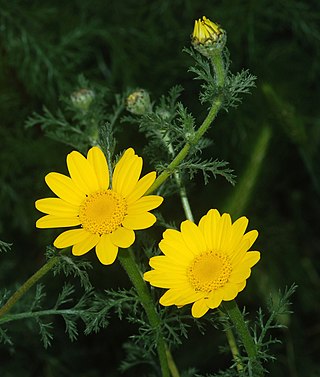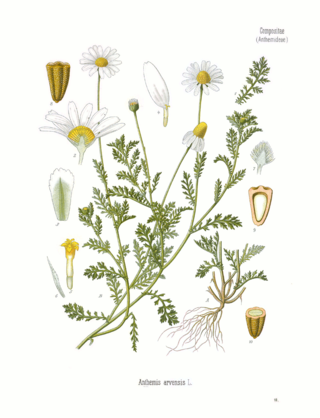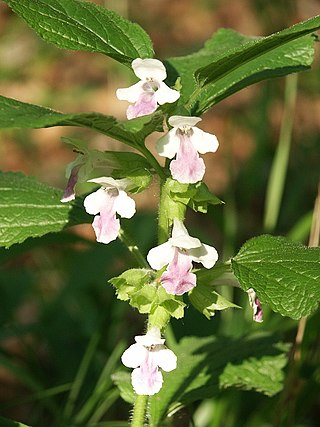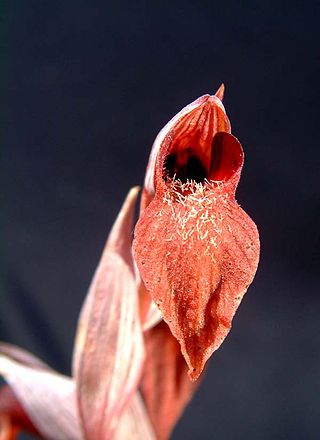
Dactylorhiza fuchsii, the common spotted orchid, is a species of flowering plant in the orchid family Orchidaceae.

Dactylorhiza is a genus of flowering plants in the orchid family Orchidaceae. Its species are commonly called marsh orchids or spotted orchids. Dactylorhiza were previously classified under Orchis, which has two round tubers.

Cota tinctoria, the golden marguerite, yellow chamomile, or oxeye chamomile, is a species of perennial flowering plant in the sunflower family. Other common names include dyer's chamomile, Boston daisy, and Paris daisy. In horticulture this plant is still widely referred to by its synonym Anthemis tinctoria.

Anthemis is a genus of aromatic flowering plants in the family Asteraceae, closely related to Chamaemelum, and like that genus, known by the common name chamomile; some species are also called dog-fennel or mayweed. Anthemis are native to the Mediterranean region and southwest Asia east to Iran. A number of species have also become naturalized in the United Kingdom and other parts of the world.

Anthyllis is a genus of flowering plants in the family Fabaceae. This genus contains both herbaceous and shrubby species and is distributed in Europe, the Middle East and North Africa. The most widespread and familiar species is A. vulneraria, a familiar grassland flower which has also been introduced to New Zealand.

Anthemis arvensis, also known as corn chamomile, mayweed, scentless chamomile, or field chamomile is a species of flowering plant in the genus Anthemis, in the aster family. It is used as an ornamental plant.

Melittis melissophyllum is a species of flowering plant in the mint family, Lamiaceae. Its common name is bastard balm. It is the only species in the monotypic genus Melittis. The genus name is derived from the Greek melitta, which is in turn from melissa.

Anthyllis vulneraria, the common kidneyvetch, kidney vetch or woundwort is a medicinal plant native to Europe. The name vulneraria means "wound healer".

Serapias is a genus of terrestrial orchids that can be found all over southern Europe to Asia Minor. The genus was named after Serapis, a syncretic Hellenistic-Egyptian god in Antiquity. Serapias have spurless flowers and usually go dormant during the winter seasons.

Scilla nana, known as dwarf glory-of-the-snow, is a bulbous perennial flowering plant endemic to Crete. It flowers in early spring with flowers in shades of lilac blue. After flowering, it goes into dormancy until the next spring. It belongs to a group of Scilla species that were formerly put in a separate genus, Chionodoxa, and may now be treated as Scilla sect. Chionodoxa. It has not always been recognized as distinct from Scilla cretica.

Pteris cretica, the Cretan brake, ribbon fern, or Cretan brake fern, is a species of evergreen fern in the family Pteridaceae, native to Europe, Asia and Africa.

The flora of Lebanon includes approximately 2,600 plant species. Situated on the eastern coast of the Mediterranean Basin, Lebanon is a reservoir of plant diversity and one of the world's biodiversity hotspots for conservation priorities. Endemic species constitute 12% of the Lebanese flora; 221 plant species are broad endemics and 90 are narrow endemics. Important Plant Areas (IPAs) featuring the country exceptional botanical richness were defined in 2018.

Ophrys kotschyi, the Cyprus bee orchid, is a terrestrial species of orchid native to Greece and Cyprus.
Scrobipalpa montanella is a moth in the family Gelechiidae. It was described by Pierre Chrétien in 1910. It is found in southern France and Sicily.

Anthemis punctata, called the Sicilian chamomile, is a species of flowering plant in the genus Anthemis, native to Algeria and Tunisia, and introduced to Sicily, Great Britain and Ireland. It has gained the Royal Horticultural Society's Award of Garden Merit as Anthemis punctata subsp. cupaniana, which may well refer to Anthemis cupaniana.

Anthemis cupaniana, called the Sicilian chamomile, is a species of flowering plant in the genus Anthemis, native to Sicily, and introduced to Great Britain and the Chatham Islands. It may have gained the Royal Horticultural Society's Award of Garden Merit as Anthemis punctata subsp. cupaniana, which may well refer to Anthemis punctata.

Anthemis cretica, the Cretian mat daisy or white mat chamomile, is a species of flowering plant in the family Asteraceae. It or its many subspecies can be found around the Mediterranean region, the Black Sea area, Poland, the Caucasus, and the Middle East as far as Iran. It is highly morphologically variable, and the namesake of a species complex.
Malva cretica is a species of flowering plant in the family Malvaceae, native to Tunisia, Sardinia, Corsica, Sicily, Italy, Albania, Greece, the eastern Aegean Islands, Crete, Cyprus, and Turkey, and introduced to France. There may be a subspecies, Malva cretica subsp. althaeoides, present in Spain.

Brassica cretica is a species of flowering plant in the family Brassicaceae, native to the Eastern Mediterranean, particularly to Greece and the Aegean Islands. It was first described by Jean-Baptiste Lamarck in 1785. A 2021 study suggested that it was the origin of cultivated Brassica oleracea, with later admixture from other Brassica species.
















